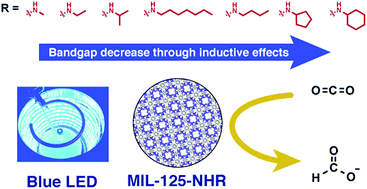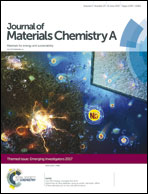Systematic variation of the optical bandgap in titanium based isoreticular metal–organic frameworks for photocatalytic reduction of CO2 under blue light†
Abstract
A series of metal–organic frameworks isoreticular to MIL-125-NH2 were prepared, where the 2-amino-terephthalate organic links feature N-alkyl groups of increasing chain length (from methyl to heptyl) and varying connectivity (primary and secondary). The prepared materials display reduced optical bandgaps correlated with the inductive donor ability of the alkyl substituent as well as high photocatalytic activity towards the reduction of carbon dioxide under blue illumination operating over 120 h. Secondary N-alkyl substitution (isopropyl, cyclopentyl and cyclohexyl) exhibits larger apparent quantum yields than the primary N-alkyl analogs directly related to their longer lived excited-state lifetime. In particular, MIL-125-NHCyp (Cyp = cyclopentyl) exhibits a small bandgap (Eg = 2.30 eV), a long-lived excited-state (τ = 68.8 ns) and a larger apparent quantum yield (Φapp = 1.80%) compared to the parent MIL-125-NH2 (Eg = 2.56 eV, Φapp = 0.31%, τ = 12.8 ns), making it a promising candidate for the next generation of photocatalysts for solar fuel production based on earth-abundant elements.

- This article is part of the themed collection: Journal of Materials Chemistry A Emerging Investigators


 Please wait while we load your content...
Please wait while we load your content...